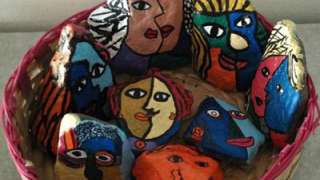MEDIA
Art in the bazaar
THE HINDU | January 30, 2016
Art Mandai, a unique project in Pune, takes art out of rarefied galleries and right into the city’s largest vegetable market.
What does being an artist entail? Sculptor Gauri Gandhi grappled with this premise for a long time. Does it only involve the ubiquitous exhibitions and participation in art conferences, the selling of art works and organising of auctions and biennales? What should an artist do?
Says Gandhi, “These are challenging questions. Are we to do the same jamboree over and over again? Financial and creative priorities cannot be overruled, but is that what my art is all about? I don’t think so.” The Pune-based Gandhi began to talk to friends and colleagues and what has emerged as a by-product of these deliberations and conversations is rather heart-warming: Art Mandai.
Art Mandai (mandai in Marathi is a vegetable market) was an attempt to take art out of the confines of gallery spaces to the people of Pune at a site of their preference. Paintings, sculptures, and photographs were displayed and sold alongside vegetables, fruits and groceries at Pune’s iconic Mahatma Phule Mandai, the largest vegetable market in the city and one of the most compelling sites of Pune’s much-cherished history.
The mandai has witnessed many upheavals in the city’s chequered cultural past. It is also a living site favoured by a plethora of social and political activists who are looking for a captive audience. The mandai almost determines the cultural epicentre of the city and is essentially a democratic space that facilitates an interaction across social strata.
On January 26, several eminent city artists including Raju Sutar, Vaishali Oak, Sujata Dharap, Indranil Garai, and Vidya Dengle, among many others, set up stalls and sold art works side by side with the vegetable vendors at the mandai. The exhibits, especially created for the project, were priced between Rs. 100 and Rs. 1,000. While artists were not restricted by any particular theme, the curator emphasises that no compromise was made in matters of aesthetics.
“Art is perceived as an elitist, unfathomable enterprise. There is an even greater anxiety about entering the gallery space. How long are we going to live with this misconception? So, there is a problem and we are trying to address it. If people refuse to come to galleries, we have to reach out to them in a space of their liking to debunk these myths. This also accords the enterprise a more inclusive character,” says Gauri.
Like their vegetable vendor counterparts, artists at the Mandai talked about their exhibits and had dialogues with visitors and buyers. “We want everybody to buy and own art. Why should we restrict ownership to a certain class? They should delight in this process of possession. Most importantly, we have to use our public spaces creatively, generate viewership, and create affordability. Sadly, our understanding of public art is often governed by ugly, disproportionate, gargantuan statues.”
Besides facilitating an introduction to art, the Art Mandai project drew people from different parts of the city to one of its most enduring structures — the historical Mahatma Phule Mandai building. It hopes to extend this kind of interaction to other sites of social and historical significance in Pune and different parts of Maharashtra by organising similar activities.
Art Mandai also featured theatre performances and artists such as Manoj and Ranjana Surve, who lack formal training in art. While Manoj works as a watchman, Ranjana is a helper at Gauri’s studio. Says author and participating artist Saaz Aggarwal, “Pune has been my home for 23 years and I love it for its pace of life (more leisurely than Bombay where I used to live) but in the past several years, it has become terribly congested. There is also a huge and continuing influx of migrants from other parts of the country, which has changed the fabric of the city and made it more interesting.”
Aggarwal had planned to exhibit her paintings at the event but after spending time at the mandai decided to create installations that would blend with the character of the place. One of the things she did was to paint little roadside stones for display and sale. “I think in the lofty world of art-making this might be known as ‘Found Art’ or something like that,” she says wryly. Inside the Mandai, though, it is just a beautiful piece of work. With no names or labels. And no fixed rules about where it must be shown or sold.
Kunal Ray teaches English Literature in Pune and writes on art and culture.

